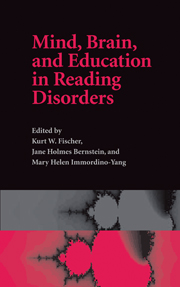Book contents
- Frontmatter
- Contents
- List of figures
- List of tables
- List of contributors
- Acknowledgements
- Part I What is Reading, and What are Reading Disorders? Looking to Neuroscience, Evolution, and Genetics
- 1 Toward a grounded synthesis of mind, brain, and education for reading disorders: an introduction to the field and this book
- 2 An evolutionary perspective on reading and reading disorders
- Essay: Brain volume and the acquisition of adaptive capacities
- 3 The genetics of dyslexia: what is the phenotype?
- Part II Reading and the Growing Brain: Methodology and History
- Part III Watching Children Read
- Part IV Reading Skills in the Long Term
- Appendix: Transcript and behavioral data from Profiles in Reading Skills (Four Boys)
- Index
- References
Essay: Brain volume and the acquisition of adaptive capacities
Published online by Cambridge University Press: 22 September 2009
- Frontmatter
- Contents
- List of figures
- List of tables
- List of contributors
- Acknowledgements
- Part I What is Reading, and What are Reading Disorders? Looking to Neuroscience, Evolution, and Genetics
- 1 Toward a grounded synthesis of mind, brain, and education for reading disorders: an introduction to the field and this book
- 2 An evolutionary perspective on reading and reading disorders
- Essay: Brain volume and the acquisition of adaptive capacities
- 3 The genetics of dyslexia: what is the phenotype?
- Part II Reading and the Growing Brain: Methodology and History
- Part III Watching Children Read
- Part IV Reading Skills in the Long Term
- Appendix: Transcript and behavioral data from Profiles in Reading Skills (Four Boys)
- Index
- References
Summary
Connection: Brain, language, and other human capacities develop in patterns shaped by both evolution and culturally defined experiences, including language and literacy. New tools for characterizing brain development provide means for analyzing development of different brain regions in relation to abilities such as speech and reading. Many classical neural imaging techniques assess the volume of particular brain regions in brains of people who have died, but newer techniques, such as magnetic resonance imaging, assess volume in brains of living people. Because volumes of different brain tissues change in diverse ways when people die, the new techniques provide the first good data on brain volume of living brains. Many hypotheses about learning disorders involve differences in size of specific areas of brain tissue, such as regions for phonological analysis in many dyslexic children (Galaburda & Sherman; Paré-Blagoev; Benes & Paré-Blagoev, this volume). With data on volume in living brains being so recent, the principles relating brain volume to development, learning, and evolution remain to be determined. Evidence has already shown that different people show different volumes for the same brain areas, and that areas which share functioning seem to covary in their volume, even when they are in widely separated brain regions.
The EditorsThere appear to be powerful constraints selected through evolution that act to set the total volume of neocortex to a narrow species-specific value (Filipek et al., 1994; Caviness et al., 1999). Within these constraints other mechanisms, operating through individual experience, adaptively modulate the volumes of specific brain regions.
- Type
- Chapter
- Information
- Mind, Brain, and Education in Reading Disorders , pp. 30 - 36Publisher: Cambridge University PressPrint publication year: 2007



